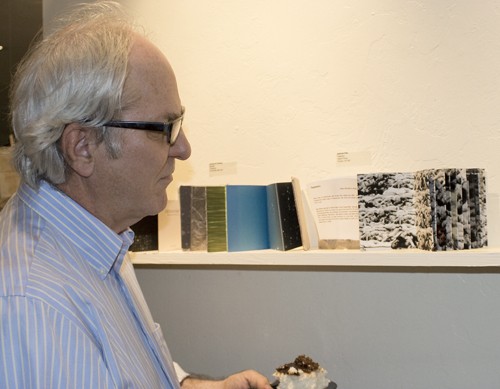It’s a line! It’s a shape! Who knows what ‘it’ is? This summer, the Tucson Museum of Art brings us a thoughtful collection of abstract artwork.
“”Into the Void”” is an exhibition running from July through September this year at the Tucson Museum of Art. The museum’s official website describes the collection as “”a celebration of the diversity of non-objective artistic expression”” featuring works from various artists, media and styles. It boasts pieces from surrealist artist Max Ernst, abstract expressionist Paul Jenkins and even a few works by Bahaus members such as Josef Albers. There are paintings, sculptures, photographs, mixed media and all kinds of artwork.
As I made my way through the exhibit, I couldn’t help but notice the diversity. Some pieces were tiny, and certain ones could fill an entire wall. Plenty were black and white, but others contained the whole spectrum of colors. Not to mention the subject matter, which could be as simple as one color of paint on a canvas or as complex as a panoramic drawing of the Grand Canyon.
At first glance, it seemed that some of these pieces could mean nothing, could be anything or were just far too unconventional to represent something real. But as I began to focus on each individual work and understand the story of its artist, the exhibit started to make sense.
One particular painting that caught my eye was an untitled work by Andrew Polk. At first, I saw nothing more than a mishmash of colors and lines. Diagonal brown brushstrokes, a splash of teal, a yellow stripe, some raindrops (maybe). But then I read the accompanying plaque, which described Polk as a man “”obsessed with tragedy, disaster, and war.”” Contemplating the painting again, I saw that it truly was chaotic. The brown brushstrokes were frantic; the shade of yellow was nauseating. The raindrop-like shapes made no sense at all, moving in a different direction than everything else and intersecting the other lines undesirably. Although the painting didn’t make its message obvious, it did succeed in representing something very real. As I became absorbed in the piece, I made a connection to that feeling of tragedy, entropy and loss. It was fascinating. Polk’s work expressed emotion loosely and without words by simplifying it into a dynamic arrangement of abstract images, colors and lines.
I also made a connection to a painting by Dorothy Fratt, entitled “”Great Day””, as well as a collage called “”All the Things in my Apartment”” by Paho Mann. As I further explored the exhibition, I realized that the selection of pieces featured in “”Into the Void”” all have a similar effect. For a place so silent and still, the exhibit’s walls are bursting with excitement. The shapes and shades of every piece have some kind of meaning or story, and once you begin to discover their messages, even the simplest of paintings can come to life.
Some people may look down on abstract artists because they don’t paint scenes that we can immediately identify, but when it comes down to it, abstract pieces represent the thoughts and feelings that aren’t always physical or tangible. If you enjoy the mystery of non-objective artwork or feel like discovering the deepest thoughts of an abstract artist, check out “”Into the Void”” before it closes this fall. You might be lucky enough to connect with a few of the unusual and inspiring pieces of the collection.









